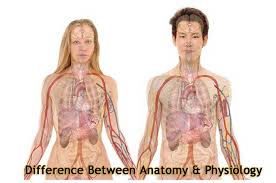What is the difference between anatomy and physiology?
Both anatomy and physiology are termed commonly used in medical science. Many students pursuing the course tend to think these terms are similar but this is not true.
The core difference between anatomy and physiology is that anatomy is the study of different body parts of human beings while physiology is the study of human body parts functions.

What Is Anatomy?
Anatomy refers to structures. The detailed explanation of anatomy is that it is the study of different body parts of humans in terms of organization and inter-relationship.
Human anatomy is quite important for medical professions to examine the injuries and wounds of the various body parts.
Anatomy can either be microscopic or macroscopic. Microscopic anatomy is the study of cells, tissues, and other tiny structures that are invisible with naked eyes.
On the other hand, macroscopic anatomy is the study of the arrangement of body parts without the need for magnification or the use of a microscope.
The convention used in the study of anatomy is classified into regional and systematic anatomy approach. Each approach is quite important is understanding the body structures.
Regional anatomy is the study of the relationship between different structures present in a specific body region like the abdomen. Systematic anatomy is the study of a group of structures that work together to perform specialized functions.
What Is Physiology?
Physiology is the study of body functions perform by different parts such as digestion, reproduction, and respiration.
The study of physiology mainly entails homeostasis. This helps to maintain the constant internal condition of living things.
Physiology simply involves physical observation of pathologic conditions of different boy parts and their functions. Some of the common terms used are urogenital, cardiovascular, and respiratory.
Comparison Chart: Anatomy vs Physiology
| Basic Terms | Anatomy | Physiology |
| Definition | It is a medical study of body structures of living things | It is the field of medical study that deals with the function of different body parts |
| Main Focus | Deals with the size, shape, and location of the body structures | Deals with chemical, physical and electrical processes in the body structures |
| Type of Study | Static study | Dynamic Study |
| Importance | Understanding the body structures of living things through dissection and separation in the medical lab | Understanding the body structure functions through a critical study of the living things |
| Examples | The study of the heart structures, chambers, veins, arteries, and valves | The study of the blood pumping by the heart |
| Type of Organism | Dead | Living |
Core Differences between Physiology and Anatomy In Point Form
- Anatomy is the study of body structures of living organisms whereas physiology is the study of body structures functions of living things.
- The experiment of anatomy is done on dead living things while physiology is done on living beings.
- Anatomy is termed as a static study while physiology is termed as dynamic study
- Anatomy help us to understand different body structures of living things while physiology helps us to understand the different functions performed by body structures
- Anatomy is divided into macroscopic and microscopic while physiology has no division
- Anatomy is approached through systematic and regional approaches unlike physiology
- An example of anatomy is the study of the heart structure, chambers, and valves while physiology is the study of blood circulation in the heart.
You May Also Like:
- Difference between Inhalation and exhalation
- Difference between Transpiration and Guttation
- Difference between Cellular Respiration and Photosynthesis
Comparison Video
Summary
Students pursuing a course in the medical field tend to encounter both anatomy and physiology. These two terms are closely related but quite different.
Anatomy involves the study of organization and arrangement of body parts while physiology is the study of how the body parts function.